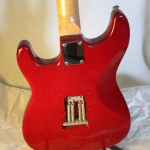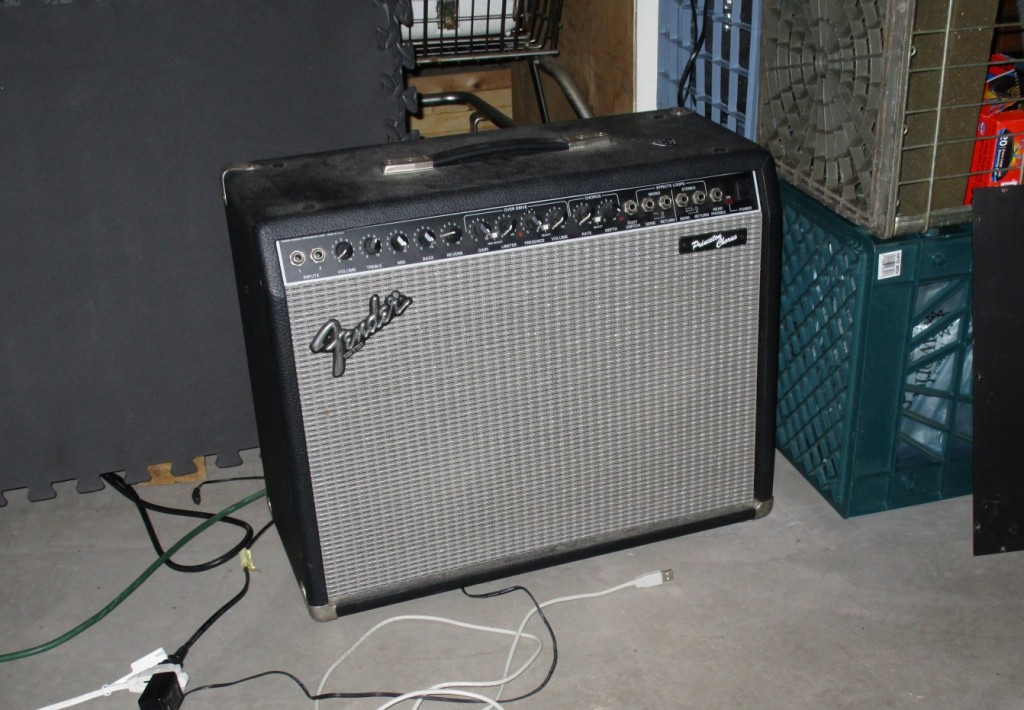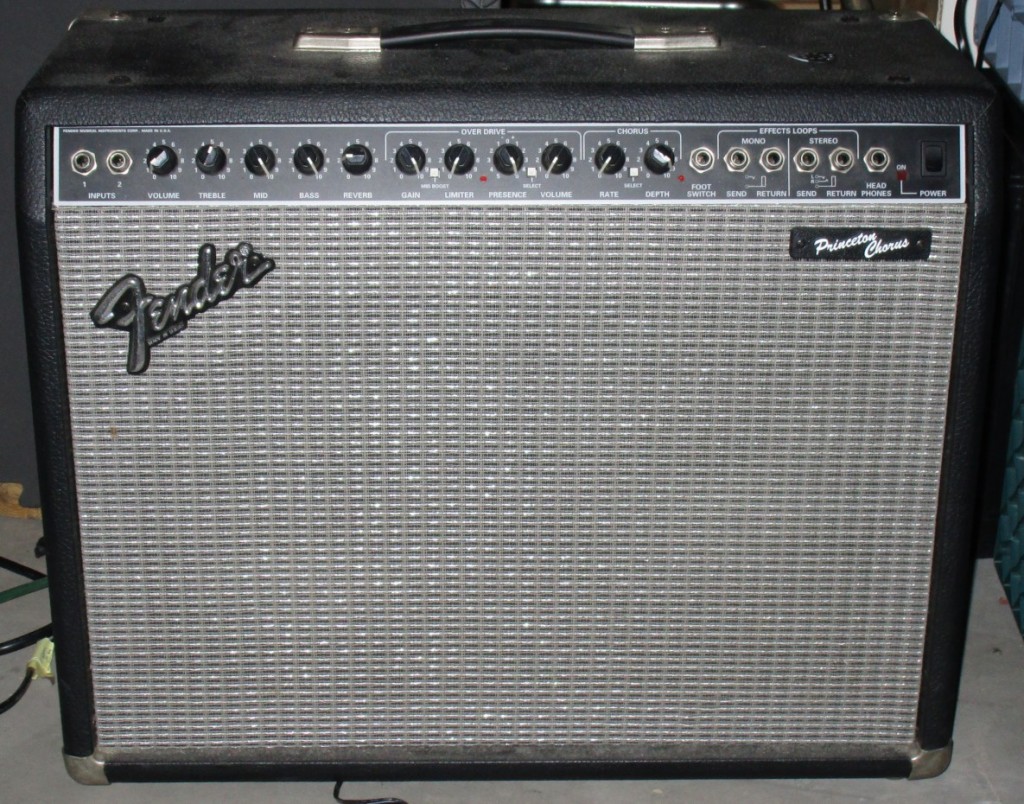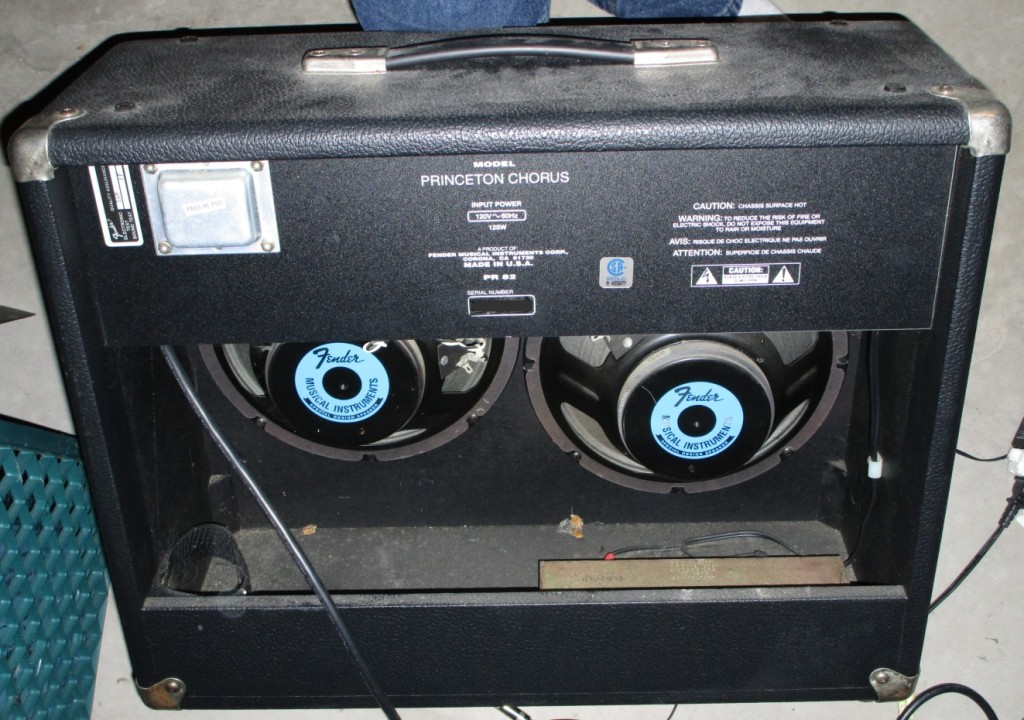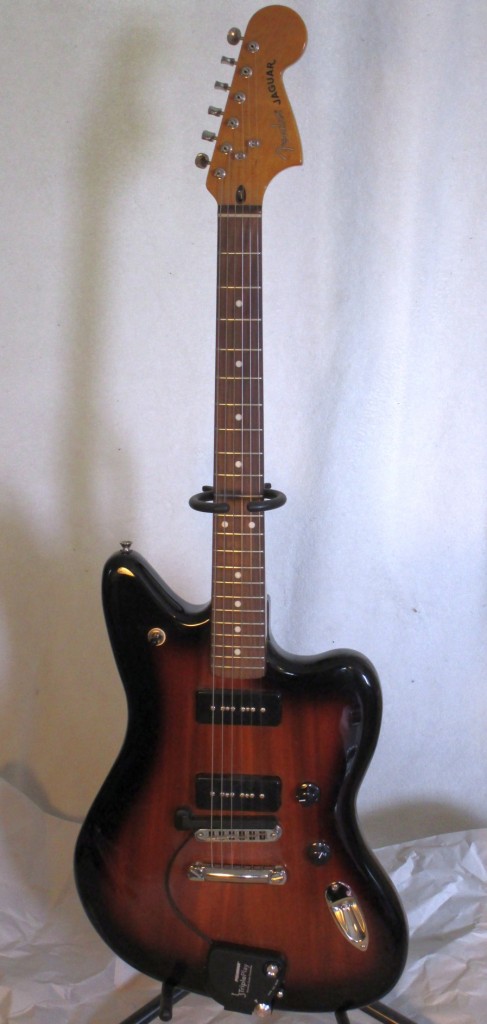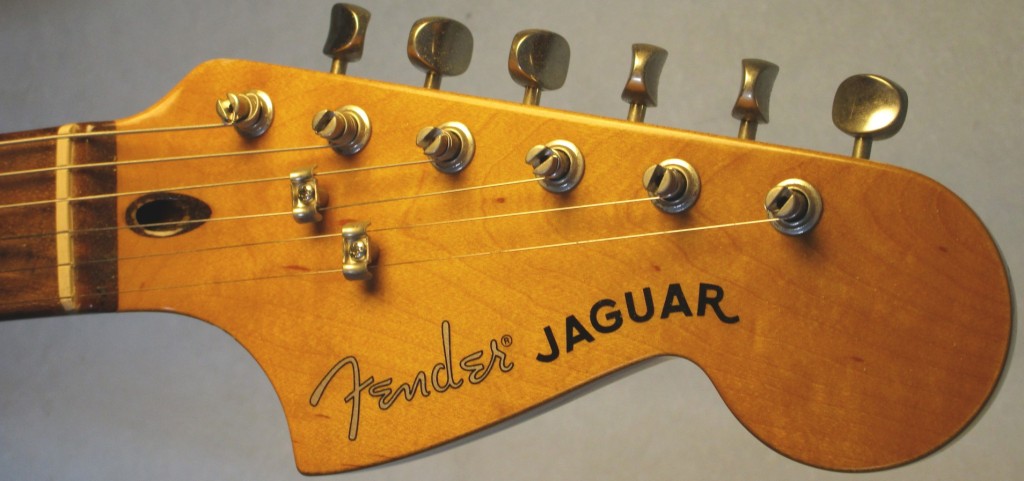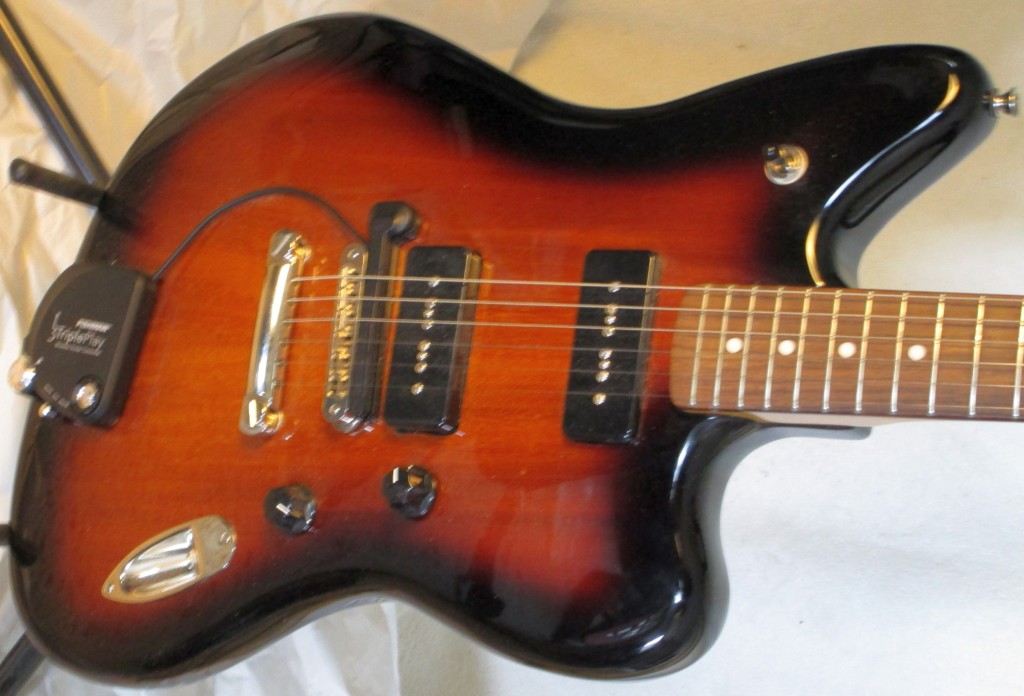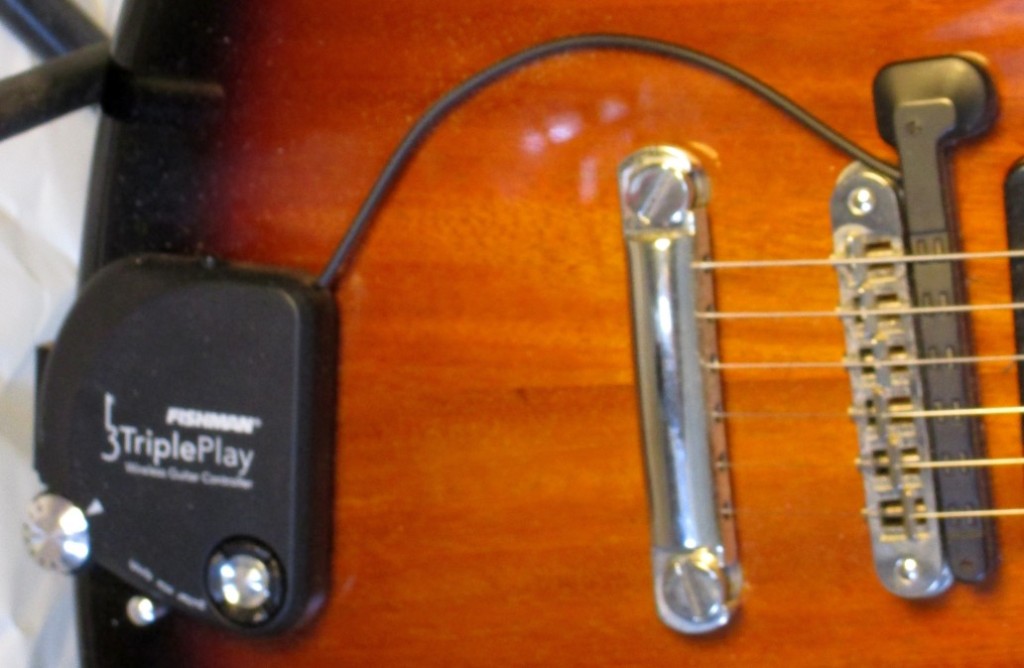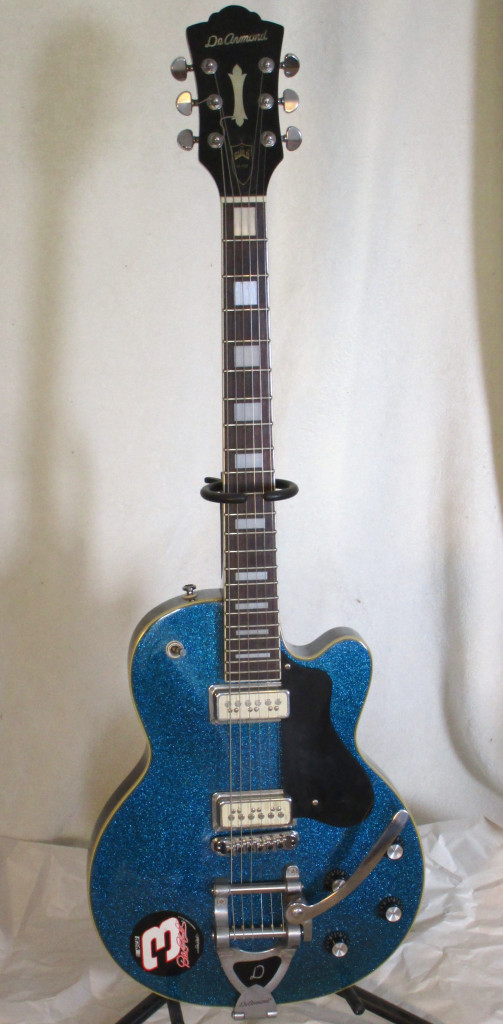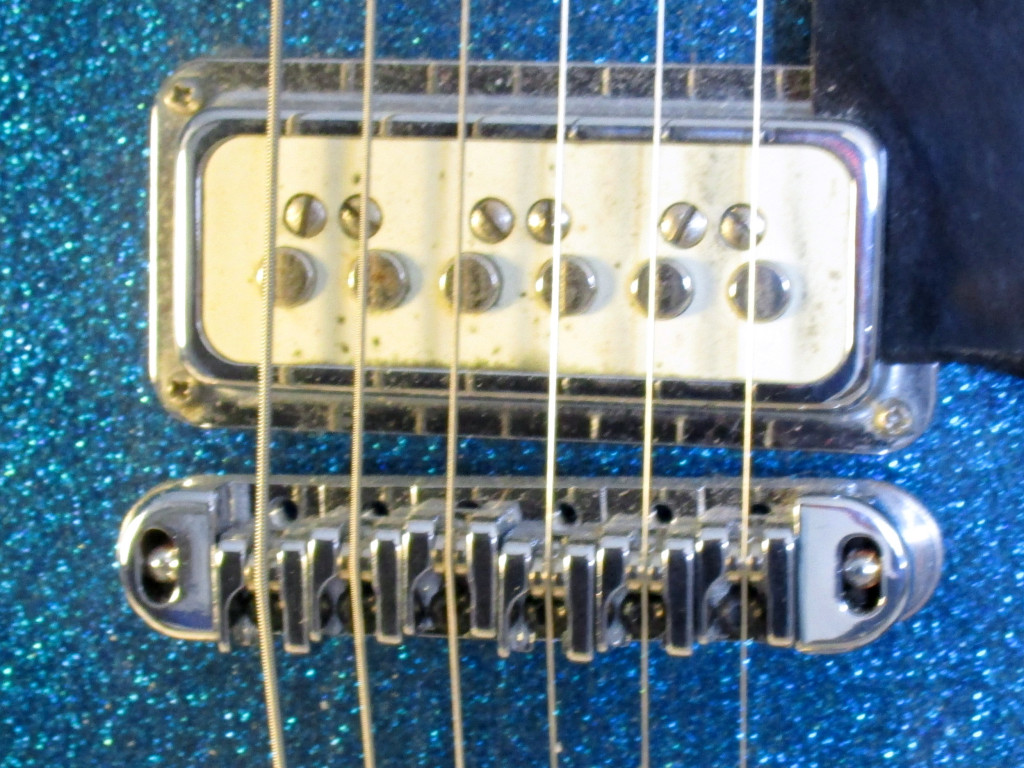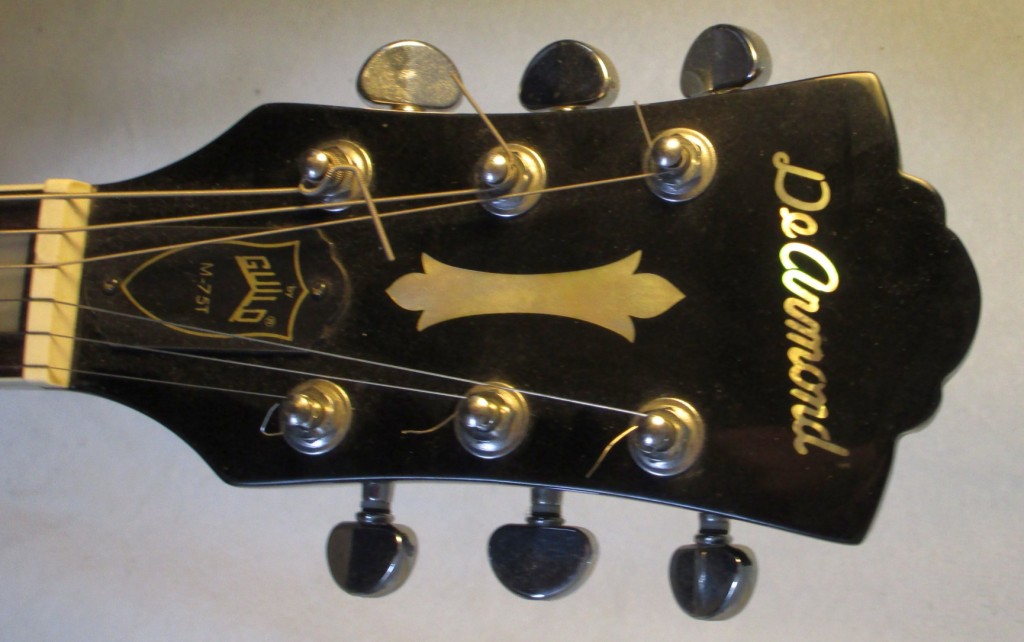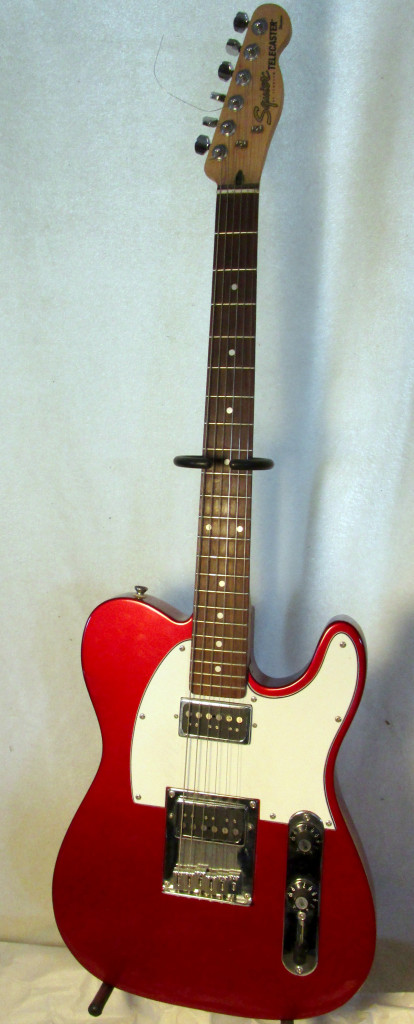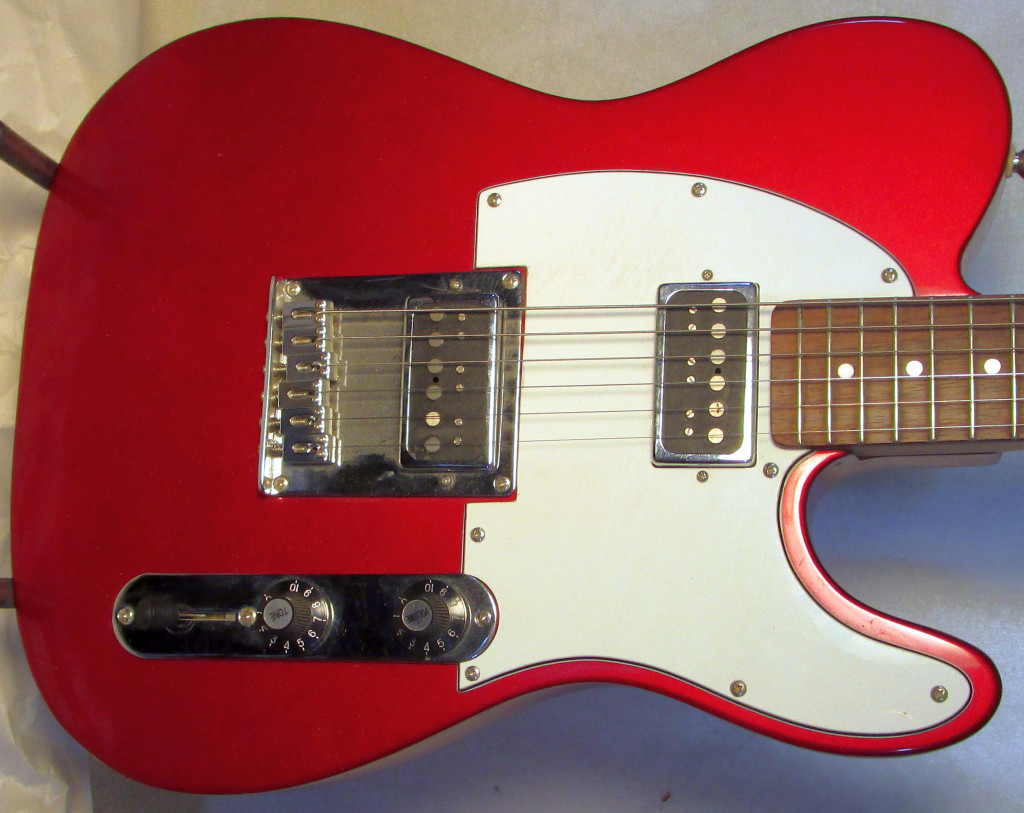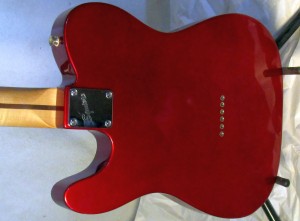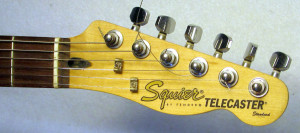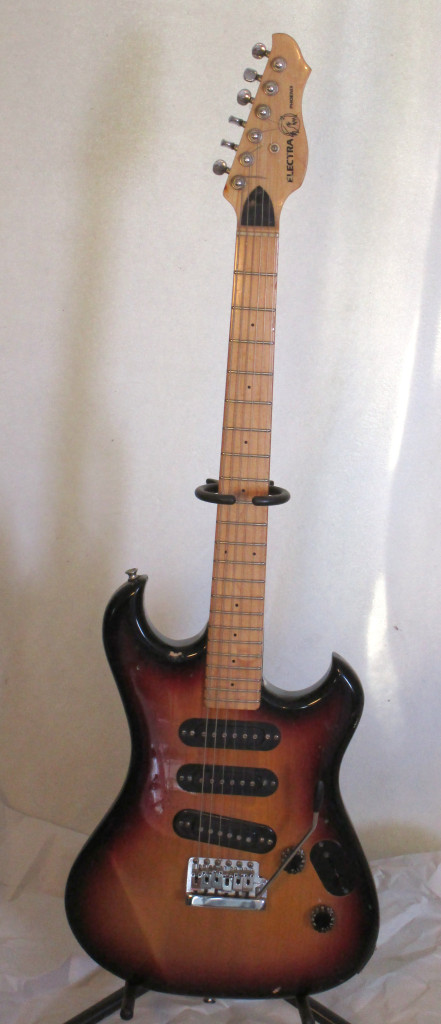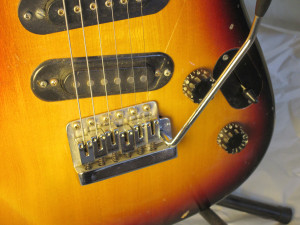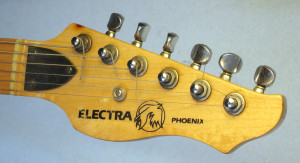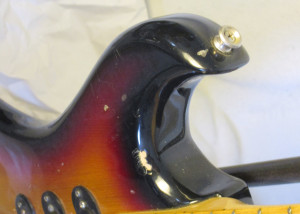New guitar imminent. Get aredy!
Author Archives: Dave
Long Time No See
I am starting a project with the 1984 Westone Concord SX. I’ve bought everything I think I need. Details next weekend.
Fernandez Strat Copy
Short post because there isn’t much to say about this generic Strat copy.
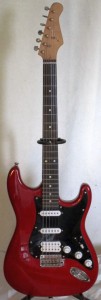
This is just a generic project guitar. I picked it up cheap because it was broken. The bridge was screwed up, the pickguard was broke and the electronics were shot. I don’t even remember if it had any pickups.
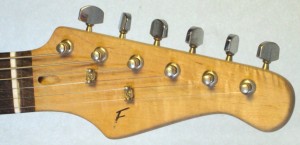 It’s what I think is a Fernandez Strat copy. Somebody sanded off most of the logo. Only the F remains. But it has the F and the headstock shape LOOKS like a Fernandez, so that’s what I’m gonna call it.
It’s what I think is a Fernandez Strat copy. Somebody sanded off most of the logo. Only the F remains. But it has the F and the headstock shape LOOKS like a Fernandez, so that’s what I’m gonna call it.
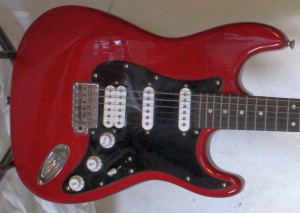 I put on a loaded pickguard from somewhere. Well, I know where. I’m just getting sick of saying “Guitar Fetish” over and over. I bought it from… Bob Fetish. It works. Nothing to complain about, but nothing inspirational either. Sounds like any decent budget priced guitar. Utterly lacking in character.
I put on a loaded pickguard from somewhere. Well, I know where. I’m just getting sick of saying “Guitar Fetish” over and over. I bought it from… Bob Fetish. It works. Nothing to complain about, but nothing inspirational either. Sounds like any decent budget priced guitar. Utterly lacking in character.
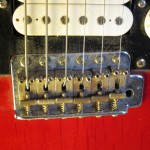 This is a Fender Mexican bridge off a busted Squier Jag-Master. The advantage of smashing a guitar out of frustration – free parts! You can also see the grain of the wood peeking through the transparent red finish if you embiggen.
This is a Fender Mexican bridge off a busted Squier Jag-Master. The advantage of smashing a guitar out of frustration – free parts! You can also see the grain of the wood peeking through the transparent red finish if you embiggen.
I don’t like how this guitar plays. It’s set up well and all, but the fretboard is too flat. It has a bevy of usable sounds, like a decent quality budget Strat copy. OK if you wanna play covers.
SUMMARY:
Condition: 9/10
– Cosmetics: 9/10 Looks good
– Working order: 10/10 Everything works
Playability: 7/10
– Rhythm Playabiliy: 6/10 Flat fretboard!
– Lead Playability: 8/10 Flat fretboard!
Sound: 6/10
– Bridge: 7/10 Solid, dependable, and boring
– Middle: 6/10 Ceramic, but not too trebly
– Neck: 6/10 Ditto the middle
Uninspiring. On my short list for resale.
Fender Princeton Chorus, Circa 1994
You can’t have a guitar page without some amps. So here’s mine.
This is my 1994 Fender Princeton Stereo Chorus. A real stereo chorus amp! Look at the schematic!
This is actually my second Fender Princeton Stereo Chorus. Both are early 90’s models with the black knobs. I still have the other one, but it needs a new volume pot.
I bought this one at Guitars on George a few years ago when they opened back up. I think it’s the same one my friend Brock owned, that he bought off my friend Reese. Or Reece. Whichever. I think I paid around $200 for it? I bought it because I was having issues with my other one.
The other one came from Campbell’s Music about 15 years ago. I paid less than $100 for it because the input jack was busted. $5 fix, and it was as good as new for 10 years or so. But then the volume control got old and started getting noisy.
This amp is alleged to be second only to the Roland Jazz Chorus. I don’t know about that. But I do know that I actually prefer these to my 1970 Fender Twin Reverb. A little. Sure, the Twin is way way way way WAY louder, but I don’t usually need to make the neighbor’s deaf. And their neighbors. And their neighbors.
The clean channel sounds very good for being pure solid state. It doesn’t even have any sort of gimmicky ‘tube sound’ tricks, like compressors or zener diodes. (There is a compressor, but that’s in the distortion channel). The classic Fender 6-6-6 setup works as well here as it does on a ‘proper’ Fender tube amp. You can almost pretend that this is a smooth little tube Princeton.
The distortion channel isn’t very good. I mean, Supernova recorded their first album with one (or maybe its big brother, the Ultimate Chorus), but they’re the only ones. There’s some good sounds to be had with the compression on and the gain turned all the way off. Fortunately, distortion pedals work a treat on the clean channel.
Around back, we see the Fender “Special Design” speakers. These are made by Eminence. Probably. Known for their big bottom end. A certain person I know complained that, although the amp has a lot of bass, it doesn’t “chunk” like a Marshall. Well, it’s a Fender! If you want to sound like Led Zeppelin, buy a Marshall! Or a Valco.
This is my current setup. MXR Distortion Plus, modded with an extra diode in the anti-parallel clipping section (for more second-order harmonics) going through a modified BBE Sonic Maximizer (I replaced the RCA jacks with 1/4″ jacks and wired it up for batteries).
I don’t use the Maximizer as an effect. I’m just trying to get a consistent tone. With most guitar amps, the treble decreases as the volume goes up and the bass decreases as the volume goes down. It’s only there so the amp sounds the same at any volume. An EQ pedal would be better, but mine is a noisy POS. Maybe I should hook up my Radio Shack 15 band stereo EQ again?
SUMMARY:
Condition: 10/10
– Basically like-new
Sound: 8/10
– Clean: 9/10 One of the best clean solid-state amps out there
– Distortion: 6/10 Usable. Keep the gain down.
Light, clean, cheap, and loud. You could play a garage or a small club with this. I have!
Lame Links: Guitar Parts Suppliers
I don’t feel like editing a bunch of pictures this week, so for THIS WEEK ONLY! I will post another Lame Links! Places I get my guitar parts!
Guitar Fetish. If you can stomach their over the top hype, this is probably your best bet for decent quality low-cost stuff. All the parts you need, from pickups to switches to complete guitars. They claim that what they sell is the same as what you’d find on a mid-priced ($300-$600) instrument from your local Guitar Barn, and I guess it is. Certainly seems better that the $99 Squiers I usually buy.
Stewart-MacDonald and Luthier’s Mercantile International. Pricey! But they have tools nobody else has. Stew-Mac leans toward electrics, and LMI is more for acoustics. LMI is also slightly cheaper. I usually only shop at them for luthier tools only, due to cost. But if I’m buying a bunch of tools, it’s sometimes cheaper to pick up a bridge or something from them to save on shipping.
Angela Instruments. A bunch of Fender OEM parts at low low prices. Good for restoration. Plus they have some oddball stuff.
Guitar Re-Ranch. Real guitar lacquer in spray cans. Much more durable than anything from the hardware store. I’ve gotten OK results with it. Someone with patience could get great results.
Guitar Parts Resource. They generally don’t have anything you can’t get cheaper at Guitar Fetish or Angela, but sometimes I want one cheap thing from each, and Guitar Parts Resource has both things in stock.
Note: I am not getting paid to link to these sites, and do not actually endorse them or anything. If you have any problems with them, that’s your problem 😉
2014 Fender Jaguar
This guitar is what happens when a cherished guitar maker decides to throw away its brand equity.
First, some history.
In the 1980’s, Fender was on the ropes. CBS Instruments had pillaged the company and burned the brand to the ground. The only reason to buy a Fender over one of the excellent imported copies was the funny headstock shape and the name on the headstock.
In the late 1980’s, Fender’s employees saved their pennies and bought out the company, and then spent the next decade or so repairing their legacy. The name “Fender” on a guitar actually meant something again. Quality went up, features were refined, new models were brought out, etc.
In order to tap into the ‘beginner instrument’ market, Fender began its Squier line. Cheap, mediocre copies of their classic instruments, sold at the same price as their competitors. Why buy a Cort Strat copy when you could buy a Cort-made Squier with the authentic Fender headstock shape for the same price?
Well, those days are gone!
The Fender employees sold out to a bunch of weasels apparently intent on squeezing every last ounce of cash out of the name.
Calling this Chinese made lump a Fender is a disgrace. Why market this as a Fender instead of a Squier? Well, maybe they figure they can charge a few more dollars for it. Maybe they think it will sell better. While the Fender mystique lasts, that is. Forget about protecting your brand – screwing people is where it’s at!
It’s not as if this is a bad guitar, per se, it’s just that this is, for all intents and purposes, a Squier. It’s like Apple putting their name on a $100 LG smartphone and calling it the new iPhone.
The fret job was very poor. It’s the worst Squier I’ve ever had. I’ve become used to using a file or a claw hammer to drive down one or two high frets, but frets were high on about half the neck!
It plays well. Now that I’ve fixed it anyway. I like the profile of the neck. Similar to my green Squier Strat with the Jazzmaster pickup. The frets are a little small for leads but usable. The short scale really helps on the big bends so that makes up for some of it.
I like that this doesn’t feel quite like a typical copy. The mix of Fender and Gibson works well enough. Like a Firebird mated with a Jaguar. The switch and the volume control aren’t in the best location, but it’s OK. Easy to get to. Too easy – I keep hitting them.
The finish is good for a low end guitar. I like the dark sunburst. Probably hiding cheap-ass wood but I don’t believe it’s plywood. The bridge and tailpiece are quite acceptable. The electronics work, it doesn’t squeal much, the cheap P-90 copies sound like cheap P-90s.
This is the only guitar I have with a flat top and a Gibson style bridge, so I decided to put the Fishman Triple Play on it. It is a wireless guitar Midi interface.
This thing works a treat. The tracking is excellent, provided you clean up your playing. If you’re looking to play guitar and Midi at once, the guitar will suffer. You will need to play very stiffly. Slurring notes together, shambodically bashing away, strumming all 6 strings and muting 5 of them with your left hand won’t do. Clean and precise.
The software works well enough. The built-in instruments work better than any of the free VST plugins I tried. I guess they have too much CPU load – they are laggy no matter how I set them up.
Basically, it is easier learning to clean up your playing to work with this thing than it is to learn a completely new instrument.
The only failing is that although it is wireless, you still need to plug your guitar into your PC’s sound card if you want to use the included guitar effects. Why can’t I plug my guitar directly into this box? A 16 bit 44.1KHz data stream would present negligible bandwidth demands.
SUMMARY: (guitar)
Condition: 9/10
– Cosmetics: 9/10 About what you expect from an imported Chinese guitar
– Working order: 9/10 Now that I fixed the frets, no big problems
Playability: 8/10
– Rhythm Playabiliy: 9/10
– Lead Playability: 7/10 The frets are a little small for shredding
Sound: 7/10
– Bridge: 7/10 Sounds like a cheap P-90
– Neck: 7/10 Also sounds like a cheap P-90!
Mutton dressed as lamb. Fender is destroying their brand by releasing this as a Fender instead of a Squier
SUMMARY: (Fishman Triple Play)
Route the guitar’s signal through the wireless Midi device and I’d recommend it to anyone. As it is, it’s better than the Roland’s I’ve tried, but more for novelty than actual use
1999 DeArmond M75t
Note: this will be my last major update for a few weeks. Vacation beckons!
Guild was acquired by Fender in the late 1990s. They decided to bring out a DeArmond line of cheaper Guilds, alà Squier. Instead of calling them Squiers, they used the DeArmond brand name, which Fender had the rights to. Read all about it here!
The M75t was the top of the line model of the Korean made range. At least, it was the most expensive. It has a Bigsby copy tremolo bridge and USA made DeArmond 2k pickups. The body is maple on top of some cheap Asian mahogany-sound alike. This guitar is very heavy. They rectified this with the next model, the semi-hollow M77t.
I bought this guitar at the Pied Piper in Huntington WV in January 2002. This model was discontinued by then, and had damaged knobs, but they didn’t give me a discount on it. Fargin’ bastages. I put on the Earnhart sticker myself. I’m not a fan. It just looks good.
The tremolo doesn’t stay in tune. It probably needs a graphite nut, but installing those requires effort, so I swapped in a roller bridge instead. Same post spacing – it just drops in! It came from Guitar Fetish, my favorite “el cheapo” guitar parts store. Well, it stays in tune a little better, that’s for sure. It’s also slightly brighter, with a touch more sustain. Decide for yourself if that’s a good thing.
This is a picture of the headstock. Yay, it’s a headstock.
The guitar plays like a Les Paul. It has the 12″ Gibson fretboard radius and close string spacing which doesn’t agree with my long skinny fingers. It’s also fat front to back, which can hurt my thumb after long playing sessions. I usually just play power chords with this guitar to limit finger pain. If you like Gibsons, you’ll like this.
This is my go-to guitar for Sex Pistols raunch and Brian Setzer twang. Also excellent for surf. There isn’t a single genre that this guitar couldn’t do. It has a lot of character, but not so much that it loses versatility.
The bridge pickup has some P90 snarl and bite, but it still has that DeArmond twang. The neck pickup is fat – downright chunky – but chords sound ill-defined with distortion. Of course, there’s massive twang in the in-between position.
SUMMARY:
Condition: 9/10
– Cosmetics: 8/10 (some visible pick marks on the pickguard)
– Working order: 10/10 (perfect)
Playability: 7/10
– Rhythm Playabiliy: 7/10 (if you like Gibsons, make that 10/10)
– Lead Playability: 7/10 (ditto)
Sound: 9/10
– Bridge: 10/10 (twangy and midrangey)
– Both: 10/10 (twang city)
– Neck: 8/10 (fat, a little muddy)
One of my favorites. Reliable and versatile. I’ve played shows with this.
2000 Squier (Cort) Telecaster
Twang King!
This is my 2000 model Squier Telecaster. My mom bought it for me for my birthday back in 2001.
It was originally the “fat” variant, with a humbucker pickup in the neck and a traditional Telecaster pickup in the bridge position. I really didn’t care for the obnoxious ceramic magnet single coil in the bridge position, so I bought a humbucker bridge and added the Guitarfetish Surf 90s.
The Surf 90 is an interesting pickup. It’s a single coil in a humbucker case. It is supposed to sound like an old DeArmond Dynasonic. I figured that hey – the Dynasonics are supposed to be ‘twangy’ pickups, and the Telecaster is supposed to be ‘twangy’, so let’s combine them! It worked rather well.
To make the guitar stand out even more, I reversed the control plate, ala Bill Kirchen. Then I put on the Muddy Waters volume and tone controls. I really like this arrangement. Working the volume control is so much easier.
The bridge Surf 90 is a tad too dark for my liking. Sounds great, but lacks a certain bite. It has alnico 2 magnets. I suppose I’d like it better with alnico 5’s. Too bad there’s no easy way to change them. Doesn’t really sound much like a Telecaster anymore, but it’s still cool.
The neck pickup is nice and fat. Not the clearest, but you can at least still hear the individual strings. It’s not all that different from the original humbucker, to be honest.
As you might expect, the magic happens in the in-between position. That’s where all the twangy goodness comes from. With both pickups in parallel, tone just oozes from this guitar. It ‘hits above it’s weight’ – lots of tone for such a cheap guitar.
Part of the reason for the more ‘expensive’ tone is that this is a true ‘string-through’ Telecaster. The strings go through the body, like the expensive Teles. Strings mounted to the bridge is a sure sign of a cheap Tele. But then a few people actually do prefer the sound of the top-mount Telecasters.
The neck on this thing is of the ‘baseball bat’ variety. I really do not like that. My thumb cramps like you wouldn’t believe. It is downright painful to play this for long periods. One day I’ll get the sander after it and profile it. Other than hurting my thumb, the guitar plays well. I’d prefer a contour body – screw tradition!
SUMMARY:
Condition: 10/10
– Cosmetics: 10/10 (needs a good cleaning)
– Working order: 10/10 (works like new)
Playability: 8/10
– Rhythm Playabiliy: 8/10 (I don’t like the baseball-bat neck, but that’s just me)
– Lead Playability: 8/10 (decent frets)
Sound: 9/10
– Bridge: 7/10 (too tame – needs more bite)
– Both: 10/10 (twang!)
– Neck: 8/10 (fat with decent clarity)
I would gig with this guitar.
Nostalgia Part 1 of 283,429
I was a little busy this weekend, watching Len Cella play the organ with his organ. Actually, I have plenty of time to write a detailed post about another one of my guitars, but if I do that each week I’ll run out in a few months and have to resort to filler posts from there on out. So I’ll put up a filler post now!
My main philosophy when it comes to modifying guitars is don’t try to do too much. It is impossible to out-engineer the people who design guitars for a living, but it is possible to eliminate the design compromises that they made to hit their price point. It’s also possible to personalize one, or maybe even make it one-of-a-kind, as long as you stay reasonable.
For example, a Gretsch is “twangy”, and so is a Telecaster. Gretsch style pickups are available in standard humbucker form, and humbucker bridges are available for Telecasters. Assuming you have a router or a good set of wood chisels, this is a straightforward mashup.
But mixing totally different guitars is a recipe for disaster. A locking Floyd won’t fit on a Gibon SG because the body is too thin. Rickenbacker pickups won’t fit on a Flying V, and a typical V needs a fat humbucker to make up for the body’s lack of resonance. Bass pickups sound awful on a guitar, even if the polepieces did line up, which they don’t.
I started modding guitars almost as soon as I got one. As I mentioned before, my first real guitar was an Electra Phoenix. It played and sounded great unplugged, but the pickups were absolute garbage. My junky Synsonics Terminator guitar, which played and sounded horrible unplugged, sounded OK through an amp. I removed the Terminator bridge pickup and put it on the Electra, and the sound improved marginally. I was hooked!
Did you ever notice that there are a lot of little screws and things on a Fender style bridge? So did I! I immediately wanted to know what they did, so I got some screwdrivers and some hex keys and began turning them all this way and that. I discovered things like how to make your guitar sound out of tune, how to make the strings buzz against the pickups, and how to make your electric guitar play like crap. Then I discovered how to fix these things.
A friend gave me a 1950s Danelectro Silvertone. Just a body and a neck. It had tuners, but no nut. The cardboard top and back were both cracked. I painted it black to hide the damage and stuck cheap pickups on it. EMG Selects, I think. Humbucker bridge, single coil neck. I used an On-Off-On switch from the hardware store and some volume knobs from Radio Shack. I cut out a piece of red acrylic for the pickguard. It looked black until I turned on the flashlight I hid inside it. I didn’t have a flat-mount bridge, so I took apart a cheap Strat style tremolo and screwed it down to the body. I drilled holes for the strings to go through, but I didn’t know what ferrules were so the string balls stuck out the back.
I think my first real ‘project guitar’ that turned out OK was a green Hondo Explorer copy. My mom got it at a yard sale for a few dollars. Just a body and a neck. I scavenged halfway decent parts for it from local guitar repair shops and sold it for a small profit.
The worst project I did that didn’t turn out was my drum-playing robot, but that’s a story for another day. The worst guitar project that turned out bad was some no-name Telecaster copy. I believe it was originally a National or Raven – same diff. Terrible guitar. I couldn’t find any cheap 6 in-line tuners locally, so I used a 3+3 set. What’s a few extra holes in the headstock? I was trying to create a junked-out guitar that somebody like Jon Spencer would have. Instead, I merely ruined it. Well, it was made from actual plywood, with a terrible, terrible neck, so I couldn’t ruin it. I mercy-killed it.
1984 (?) Electra Phoenix
This Electra Phoenix was my first real electric guitar. Well, the others were real in a technical sense. It wasn’t like my Synsonics Terminator was an ‘air guitar’. But that guitar was just a toy. Nobody takes a guitar with a built-in speaker seriously – not even me.
I believe I got this for my fifteenth birthday. That would have been 1991. Or maybe my sixteenth. My mom bought it and a solid state Marshall practice amp at a yard sale for $60.
This Electra Phoenix obviously looks a lot like my Westone Concord SX. Same body shape, same headstock, same wood type (maple), same tiny position markers. This was one of the last Electra models imported by Saint Louis Music before they switched to Matsumoku’s Westone brand. That makes it an early1984 model, or possibly late 1983. I could check the serial number but I don’t care.
It plays like my other Matsumoku guitars – low action, comfortable neck, but the frets are too small for shreddin’ and headbangin’. Fortunately I specialize in Johnny Ramone slash-and-burn bar chords. This isn’t meant to be a Super-Strat anyway.
The tremolo is a heavy brass unit I bought somewhere. I think Campbell’s Music? I don’t like it. I’ll put the original bridge back on if I find it. The bridge pickup was lame, so I replaced it with the bridge pickup from the Synsonics Terminator. Shockingly, it sounds pretty good. I usually play it in conjunction with the middle pickup. It has a great hollow, gutteral midrange bark that no other guitar I’ve ever owned has. Sort of like a really mellow wha-wha pedal pressed halfway down. Too bad it feedbacks easily, either pickup sucks on its own, and the neck pickup also sucks. Shrill!
This guitar is chipped all to Hell. Teenagers shouldn’t be allowed to own things. The burn on the headstock was because I put a cigarette there the first time I played a show. I’ve never smoked – not even tobacco! I just thought it would look dumb if I had a cigarette there and didn’t take a drag from it. Boy was I right. People just didn’t get ‘meta’ humor back then.
As I am fond of saying, this guitar is a one-trick pony. Aren’t all my guitars? Well, the American Standard Strat isn’t. I can’t get a bad sound out of that guitar! But this one only has that one great hollow sound that I can’t duplicate with my other guitars, so I’ve kept it. Plus, it’s a sentimental thing. Sort of like the way some guys stay married to their first wife. Divorce already!
SUMMARY:
Condition: 6/10
– Cosmetics: 4/10 (lots of chips and dings, probably needs professional repair)
– Working order: 9/10 (no major gremlins)
Playability: 8/10
– Rhythm Playabiliy: 10/10
– Lead Playability: 6/10 (small frets, typical Matsumoku)
Sound: 6/10
– Bridge: 1/10 (shrill, feedback)
– Bridge+Middle: 9/10 (awesome hollow midrangey sound)
– Middle: 2/10 (shrill)
– Neck: 2/10 (shrill)
Nice studio guitar. A face for radio, as the saying goes.
